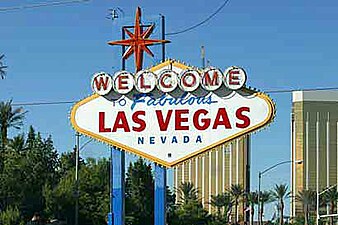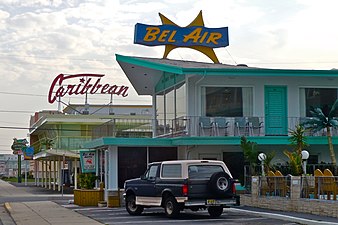古奇建筑

古奇建筑(英语:Googie architecture)是一种现代建筑的形式,属于未来主义建筑的一种,受到汽车文化、喷射机、太空时代和核子时代的影响[1]。
历史[编辑]
古奇建筑在1940年代晚期起源于美国南加州,并延续至1960年代中期,在汽车旅馆、咖啡店和加油站建筑中十分流行。古奇风格随后成为世纪中期现代主义的一部份,其中的设计要素反映了当时在美国流行的“populuxe”美学[2][3],埃罗·沙里宁的TWA飞行中心即为一例。
古奇的英文(Googie)原名来自一间现已歇业的西好莱坞咖啡店[4],由约翰·洛特纳(John Lautner)设计[5]。古奇建筑的近似风格有时又称作“Doo Wop”[6]。
特征[编辑]
古奇建筑风格的特征包括向上倾斜的屋顶、曲线的几何形状,以及大胆采用玻璃、钢铁和霓虹灯。太空时代中象征动作的设计元素也出现在古奇建筑中,包括回力镖、飞碟、原子和抛物线,以及其他自由形态的要素,例如“柔和”的平行四边形等。这些设计风格要素反映了美国社会对太空时代的著迷,以及市场上对未来主义设计的重视与强调。
与1930年代的装饰风艺术相同,古奇风格随著时间的经过逐渐变得不受重视,许多此一风格的建筑也被拆除。而其中保存下来的包括一间最古老的麦当劳餐厅(位于加州唐尼市),已在1983年被列入美国国家史迹名录。
例子[编辑]
-
Elm Road 露天汽车电影院
资料来源[编辑]
- ^ Friedlander, Whitney. Go on a SoCal hunt for Googie architecture. Baltimore Sun. Los Angeles Times. 2008-05-18 [2009-02-11]. (原始内容存档于2014-01-06).
It was the 1950s. America was a superpower, and the Los Angeles area was a center of it. The space race was on. A car culture was emerging. So were millions of postwar babies. Businesses needed ways to get families out of their automobiles and into coffee shops, bowling alleys, gas stations and motels. They needed bright signs and designs showing that the future was now. They needed color and new ideas. They needed Googie.
- ^ Stager, Claudette; Carver, Martha. Looking Beyond the Highway: Dixie Roads and Culture. Univ. of Tennessee Press. 2006: 158 [2013-08-09]. ISBN 978-1-57233-467-0.
- ^ Cotter, Bill; Young, Bill. Populuxe and Pop Art. The 1964-1965 New York World's Fair. Arcadia Publishing. 2004: 51 [2013-08-09]. ISBN 978-0-7385-3606-4.
- ^ Nelson, Valerie J. Eldon Davis dies at 94; architect designed 'Googie' coffee shops. Los Angeles Times. 2011-04-26 [2011-05-15]. (原始内容存档于2019-12-10).
- ^ John Lautner (页面存档备份,存于互联网档案馆) Why Do Bad Guys Always Get The Best Houses? by Rory Stott ArchDaily
- ^ Doo Wop Motels: Architectural Treasures of The Wildwoods by Kirk Hastings 2007, p.2
外部链接[编辑]
| 维基共享资源上的相关多媒体资源:古奇建筑 |
- Lotta Living(页面存档备份,存于互联网档案馆),一个古奇建筑风格爱好者的网路社群
- Googie Architecture Online (页面存档备份,存于互联网档案馆)
- Roadside Peek: Googie Central(页面存档备份,存于互联网档案馆)
- The 1964-1965 New York World's Fair(页面存档备份,存于互联网档案馆)
| ||||||||||||||||||||||||||||||||
| ||||||||||||||||||||||||||||||||||||||||||||||



